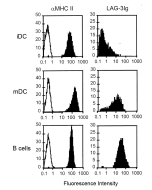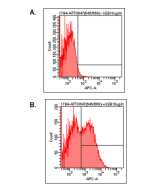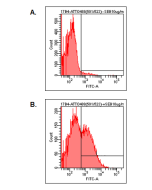Cookie Policy: This site uses cookies to improve your experience. You can find out more about our use of cookies in our Privacy Policy. By continuing to browse this site you agree to our use of cookies.
AdipoGen Life Sciences
anti-LAG-3 (human), mAb (blocking) (17B4)
As low as
470
CHF
CHF 470.00
In stock
Only %1 left
AG-20B-0012-C100100 µgCHF 470.00

| Product Details | |
|---|---|
| Synonyms | Lymphocyte Activation Gene-3; FDC Protein; CD223 |
| Product Type | Monoclonal Antibody |
| Properties | |
| Clone | 17B4 |
| Isotype | Mouse IgG1κ |
| Source/Host | Purified from concentrated hybridoma tissue culture supernatant. |
| Immunogen/Antigen | Synthetic peptide corresponding to 30 aa in the N-terminus of human LAG-3. |
| Application |
Flow Cytometry |
| Crossreactivity | Human |
| Specificity |
Recognizes human LAG-3. |
| Purity | ≥95% (SDS-PAGE) |
| Purity Detail | Protein G-affinity purified. |
| Endotoxin Content | <0.001EU/μg purified protein or <1EU/mg purified protein (LAL test; Lonza). |
| Concentration | 1mg/ml |
| Formulation | Liquid. In PBS containing 0.02% sodium azide. |
| Isotype Negative Control | |
| Shipping and Handling | |
| Shipping | BLUE ICE |
| Short Term Storage | +4°C |
| Long Term Storage | -20°C |
| Handling Advice |
After opening, prepare aliquots and store at -20°C. Avoid freeze/thaw cycles. |
| Use/Stability | Stable for at least 1 year after receipt when stored at -20°C. |
| Documents | |
| MSDS |
 Download PDF Download PDF |
| Product Specification Sheet | |
| Datasheet |
 Download PDF Download PDF |
Description
Lymphocyte activation gene 3 (LAG-3; CD223) plays an important role in negatively regulating T cell proliferation, function and homeostasis. It is required for maximal natural and induced regulatory T cell (Treg) function. LAG-3 is closely related to the T cell co-receptor CD4 and binds to MHC class II molecules but with a significantly higher affinity than CD4.
Product References
- Characterization of the lymphocyte activation gene 3-encoded protein. A new ligand for human leukocyte antigen class II antigens: E. Baixeras, et al.; J. Exp. Med. 176, 327 (1992)
- Cellular expression and tissue distribution of the human LAG-3-encoded protein, an MHC class II ligand: B. Huard, et al.; Immunogenetics 39, 213 (1994)
- Characterization of the major histocompatibility complex class II binding site on LAG-3 protein: B. Huard, et al.; PNAS 94, 5744 (1997)
- CD3/TCR complex-associated lymphocyte activation gene-3 molecules inhibit CD3/TCR signaling: S. Hannier, et al.; J. Immunol. 161, 4058 (1998)
- T Lymphocytes infiltrating various tumour types express the MHC class II ligand lymphocyte activation gene-3 (LAG-3): role of LAG-3/MHC class II interactions in cell-cell contacts: C.E. Demeure, et al.; Eur. J. Cancer 37, 1709 (2001)
- Immunological mechanisms elicited at the tumour site by lymphocyte activation gene-3 (LAG-3) versus IL-12: sharing a common Th1 anti-tumour immune pathway: E.D. Carlo, et al.; J. Pathol. 205, 82 (2005)
- The negative regulatory function of the lymphocyte-activation gene-3 co-receptor (CD223) on human T cells: L. Macon-Lemaitre and F. Triebel; Immunology 115, 170 (2005)
- A soluble lymphocyte activation gene-3 (sLAG-3) protein as a prognostic factor in human breast cancer expressing estrogen or progesterone receptors: F. Triebel, et al.; Cancer Lett. 235, 147 (2006)
- Human dendritic cells acquire a semimature phenotype and lymph node homing potential through interaction with CD4+CD25+ regulatory T cells: J. Bayry, et al.; J. Immunol. 178, 4184 (2007)
- Human lymphocyte activation gene-3 molecules expressed by activated T cells deliver costimulation signal for dendritic cell activation: C. Casati, et al.; J. Immunol. 180, 3782 (2008)
- Peripheral Tr1 and Foxp3+ Treg as Markers of Recurrent Malignancies in Patients with Hepato-Biliary Pancreatic Cancer: T. Ikemoto, et al.; Anticancer Res. 37, 5441 (2017)
- Blockade of LAG3 enhances responses of tumor-infiltrating T cells in mismatch repair-proficient liver metastases of colorectal cancer: G. Zhou, et al.; OncoImmunology 7, e1448332 (2018)
- Targeting LAG-3 and PD-1 to Enhance T Cell Activation by Antigen-Presenting Cells: F.S. Lichtenegger, et al.; Front. Immunol. 9, 385 (2018)
- Association Between Expression Level of PD1 by Tumor-Infiltrating CD8+ T Cells and Features of Hepatocellular Carcinoma: HD. Kim, et al.; Gastroenterology 155, 1936 (2018)
- A T-cell–engaging B7-H4/CD3-bispecific Fab-scFv Antibody Targets Human Breast Cancer: A. Iizuka, et al.; Clin. Cancer Res. 25, 2925 (2019)
- Efficient expansion of human granzyme B–expressing B cells with potent regulatory properties: M. Chesneau, et al.; J. Immunol. 205, 2391 (2020)
- Expansion of donor-unrestricted MAIT cells with enhanced cytolytic function suitable for TCR redirection: T. Parrot, et al.; JCI Insight 6, e140074 (2021)
- Single-cell profiling identifies impaired adaptive NK cells expanded after HCMV reactivation in haploidentical HSCT: E. Zaghi, et al.; JCI Insight 6, e146973 (2021)
- The multi-specific VH-based Humabody CB213 co-targets PD1 and LAG3 on T cells to promote anti-tumour activity: C.J. Edwards, et al.; Br. J. Cancer 126, 1168 (2022)
- Measurement of LAG-3 Expression Across Multiple Staining Platforms With the 17B4 Antibody Clone: J.B. Wojcik, et al.; Arch. Pathol. Lab. Med. 147, 1307 (2023) [IHC-FFPE]









